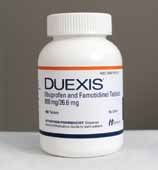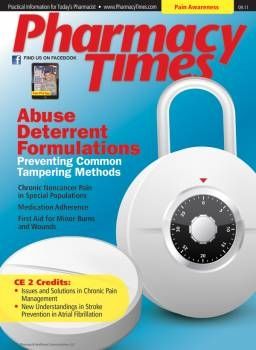Publication
Article
Pharmacy Times
Horizon Pharma's Duexis
Author(s):
The FDA approved Duexis (ibuprofen and famotidine), a new drug for treating the signs and symptoms of rheumatoid arthritis and osteoarthritis and lowering the risk of gastrointestinal ulcers.

The FDA has approved Horizon Pharma, Inc’s Duexis (ibuprofen 800 mg and famotidine 26.6 mg) for the relief of the signs and symptoms of rheumatoid arthritis and osteoarthritis and to decrease the risk of developing upper gastrointestinal (GI) ulcer. In clinical trials, upper GI ulcer was defined as gastric and/or duodenal ulcers in patients who were already taking ibuprofen for these indications.1
An estimated 46 million Americans are affected by arthritis, and by 2030, this prevalence is expected to rise by 40% to 67 million individuals. Although nonsteroidal anti-inflammatory drugs (NSAIDs) are effective pain relief agents, GI side effects often limit their use and may lead to serious complications.2 The patients enrolled in the clinical trials for Duexis were primarily younger than 65 years old and had no prior history of GI ulcer. Clinical trials did not last longer than 6 months.1
Pharmacology/Pharmacokinetics
Like other NSAIDs, the exact mechanism of ibuprofen in unknown. It is believed to exert its analgesic and antipyretic effects through prostaglandin synthetase inhibition. Famotidine inhibits gastric acid secretion through competitive inhibition of histamine H2-receptors.
The elimination half-life of famotidine is closely related to creatinine clearance; patients with a creatinine clearance less than 50 mL/min should not be given Duexis. The effect of gender, age, and hepatic impairment on the pharmacokinetics of Duexis have not been studied.1
Dosing and Administration
Duexis should be given as 1 tablet (ibuprofen 800 mg/famotidine 26.6 mg) orally 3 times a day. The tablet should be swallowed whole and never cut, chewed, crushed, or divided.1
Clinical Trials
Duexis was evaluated in 2 multicenter, double-blind, active-controlled, randomized 24-week trials. Patients received either Duexis or ibuprofen 800 mg in approximately a 2:1 ratio.1 The first trial showed a statistically significant reduction in the incidence of gastric ulcers in patients using Duexis (8.7%) compared with patients using ibuprofen alone (17.6%). The second trial showed a statistically significant reduction in the incidence of upper GI ulcers in patients using Duexis (10.5%) compared with patients using ibuprofen alone (20.0%).2
Contraindications, Warnings, and Precautions
Duexis carries the following boxed warning:
- NSAIDs may increase the risk of serious cardiovascular thrombotic events, myocardial infarction, and stroke, which may be fatal. This risk may increase with duration of treatment and in patients with cardiovascular disease or risk factors for cardiovascular disease.
- Duexis is contraindicated for the treatment of perioperative pain in the setting of coronary artery bypass graft surgery (CABG).
- NSAIDs cause an increased risk of serious GI adverse reactions, such as bleeding, ulceration, and perforation of the stomach or intestines. These reactions may occur at any time, without warning symptoms, and may be fatal. Elderly patients are at greater risk.
Duexis is contraindicated in patients with a history of asthma, urticaria, or allergic reaction after taking aspirin or other NSAIDs, during the perioperative period of CABG surgery, in pregnant patients at 30 or more weeks gestation, and in patients with a known hypersensitivity to other H2-receptor blockers.
Duexis should be used cautiously in patients with hypertension, congestive heart failure, or edema. Discontinue Duexis if bleeding, anaphylaxis, or serious skin reactions occur. Long-term use of NSAIDs can lead to renal injury. Discontinue Duexis if abnormal liver tests persist or worsen, if clinical signs and symptoms of liver disease occur, or if systemic manifestations occur.
Use caution when concomitantly administering Duexis and the following medications: warfarin, aspirin, angiotensin converting enzyme inhibitors, diuretics, lithium, methotrexate, selective serotonin inhibitors, and cholestyramine.1
The most common adverse reactions (≥1% and greater than ibuprofen alone) are nausea, diarrhea, constipation, upper abdominal pain, and headache.2
Dr. Holmberg is a pharmacist who resides in Phonenix, Arizona.
References
1. Duexis complete prescribing information. www.duexis.com/DUEXIS%20Prescribing%20Information.pdf. Accessed July 2011.
2. Horizon Pharma announces FDA approval of Duexis (ibuprofen/famotidine) for the relief of the signs and symptoms of rheumatoid arthritis and osteoarthritis and to decrease the risk of developing upper gastrointestinal ulcers [press release]. www.horizonpharma.com/ArticleDetail.asp?tid=166. Accessed July 2011.







